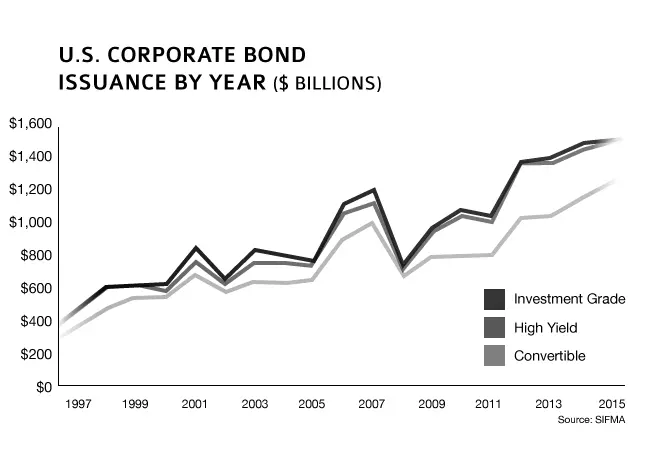BOND INVESTING CONSIDERATIONS
Introduction
Investor demand for corporate bonds has been strong in recent years (see below), likely as a result of low benchmark government interest rates driving demand for higher yield alternatives. Despite higher yields than government bonds and lower risk compared to stocks, considerations need to be given before investing in corporate bonds.

Risk Factors
Key risk factors for investors investors to consider when investing in corporate bonds include: industry risk, economic risk, country specific risk, interest rate risk, credit spread risk, default risk, call risk, liquidity risk, inflation risk, currency risk, and event risk. Descriptions of each type of risk can be found here.
Key Bond Features
A credit rating is an objective, third-party measure of an issuer’s financial health, its ability to meet its debt obligations. The credit rating accounts for business and financial risks involved with investing in an issuer’s bonds. Investors should use credit ratings to supplement issuer-specific research and analysis.
- Term to Maturity - long term bonds (10+years) offer investors higher yield compared to short term bonds but they are also exposed to higher interest rate risk.
- Floating vs. Fixed Interest - floating-rate notes with interest coupons referencing a benchmark rate (i.e. USD LIBOR) provide investors protection against increases in market interest rates. This is because investors receive higher interest payments as LIBOR rises. Conversely, fixed rate bonds provide investors attractive returns when market interest rates decline, as the coupons are relatively higher than the market interest rate.
- Collateral - bonds can be either secured or unsecured, with secured bonds backed by collateral. Unsecured bonds have higher risk of not getting repaid and therefore offer investors higher yields.
-
Seniority - this refers to a bond’s priority
of claims to the issuer’s assets. The priority
of claims is as follows:
The more subordinated the bond is the higher the risk an investor will not be repaid, however, these bonds should offer investors the highest yields.

- Optionality - bonds frequently include option features. Two common option features are call options and put options. A bond with a call option, often referred to as a “callable” bond, allows the issuer to repurchase the bond at predetermined dates and prices; investors are compensated for the call risk with a higher yield. A bond with a put option, often referred to as a “puttable” bond, gives bondholders the option to sell the bond back to the issuer at predetermined dates and prices; this lowers the investment risk for investors and thus offers a lower yield.
FUNDAMENTAL DEMAND FOR FIXED INCOME PRODUCTS
Fundamental Demand for Fixed Income Products
Despite potentially higher rates and shrinking market liquidity, bonds will still play an important role in most investor's portfolios due to their fundamental characteristics.
Bonds are a great mechanism to preserve capital. Specifically, bonds will repay investor principal on a pre-determined date, provided that the issuer does not default. This characteristic makes bonds particularly attractive to more risk-averse investors.
Secondly, bonds provide diversification to portfolios. Bonds, seen as a safe haven by investors, tend to have an inverse relationship with stocks. For example, S&P 500 lost over 40% in 2008 while 5-year US treasury increased by 7.5%. Bonds, especially high grade government bonds, can smooth the return of investors portfolio, providing much needed diversification in a recessionary environment where stocks underperform.
Another important feature of bonds is predictable cash flows. In general, most bonds offer investors fixed income on a pre-set schedule, usually semi-annually. Unlike stock dividends which are usually at the discretion of companies, coupon payments are mandatory and the inability to remunerate will lead to a default of bond issuers. This feature is well sought-after in the investor community and is critical to an important investment strategy – liability driven investing. As the name suggests, this refers to the investment strategy that aims at generating cash flows to fund future liabilities. Institutions like insurance companies and pension funds, as well as individual investors, often employ this strategy.
Capital appreciation of bonds can also make them an attractive investment opportunity. There are several reasons why bond prices increase. First, bond yield and bond price have an inverse relationship. This means that a decline in interest rates will likely increase the cost of the bond overall. Enhancement of issuer creditworthiness may also push bond prices up. Finally, bonds rally when demand outweighs supply. There are some exceptions to this rule, including in the US where fed is poised to hike rates, and regions such as Europe, Japan, and China where central banks are fighting against slowing economy and deflation with massive QE programs and historical low yields. If investors sell bonds after prices have increased but before maturity, they can experience profit in the form of capital gains.
Lastly, some bonds offer attractive tax benefits. Most municipal bonds, for example, are free from federal income taxes. This is particularly appealing to high income investors.
References:
- PIMCO: Everything You Need to Know About Bonds


